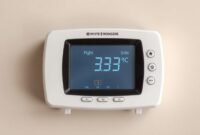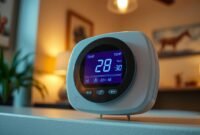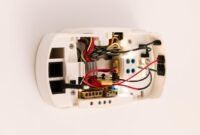Are you getting frustrated with your Honeywell thermostat flashing “Cool On”? It can really mess up your home’s comfort. This flashing can make you worry about big HVAC system problems.
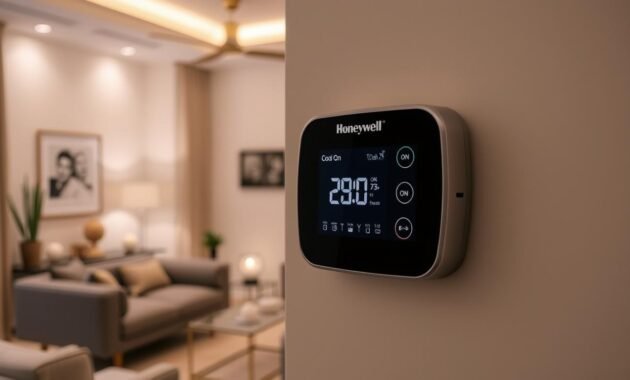
The constant flashing might seem scary, but it’s usually not a big deal. It’s a safety feature to protect your air conditioning. Our guide will show you how to understand the flashing, find out why it happens, and fix it to keep your home cool.
I’ll explain the Honeywell thermostat flashing cool message. You’ll learn how to fix it yourself. This way, you can avoid expensive repairs from professionals.
Understanding the Cool On Flashing Message
When your Honeywell thermostat display starts blinking in cool mode, it’s sending you an important signal about your home’s cooling system. This flashing cool mode indicator isn’t just a random light show – it’s a sophisticated communication tool designed to protect your HVAC equipment.
The thermostat settings play a key role in understanding these display messages. A blinking “Cool On” usually means one of several important system protection mechanisms:
- Compressor protection delay
- Startup safety feature
- Power interruption recovery
- System diagnostic mode
Read also: Honeywell Thermostat Battery Replacement in Easy Ways
Decoding the Flashing Indicator
Most Honeywell thermostats use a specific flashing pattern to communicate system status. A typical delay can last up to 5 minutes. This delay helps prevent damage to your air conditioning compressor.
This built-in protection prevents short cycling – a harmful condition where the system turns on and off too quickly.
Normal vs Problematic Patterns
Not all thermostat blinking cool signals are cause for alarm. Here’s a quick breakdown:
- Normal flashing: 3-5 minutes after system restart
- Prolonged flashing: Possible system issue
- Continuous blinking: May need professional inspection
HVAC System Impact
Understanding these thermostat display messages can save you from costly repairs. The flashing cool mode is your system’s way of ensuring safe, efficient operation. By respecting these built-in protection mechanisms, you’re helping extend the life of your air conditioning equipment.
Common Reasons for Thermostat Display Messages
When your Honeywell thermostat flashes “Cool On,” it’s important to know why. The troubleshooting guide shows several reasons for these messages. They can affect how well your cooling system works.
One main reason is compressor protection. This safety feature stops your AC from starting too fast. It keeps the system safe from damage. Usually, it waits up to five minutes before starting again.
- Power-related interruptions can trigger display messages
- Incorrect thermostat settings may cause unexpected blinking
- Indoor or outdoor AC unit complications can generate warning signals
Voltage changes also make your thermostat blink. After losing power, it needs 5 to 10 minutes to start again. This helps avoid damage to the compressor.
It’s key to understand these messages to keep your HVAC system running well. Regular care, like changing air filters and checking power, can prevent problems. This includes thermostat and AC issues.
| Potential Cause | Recommended Action |
|---|---|
| Compressor Protection | Wait 5 minutes before restarting |
| Power Interruption | Check circuit breakers and connections |
| System Settings | Verify thermostat configuration |
If you keep having problems, getting help from an HVAC expert is a good idea. They can do a detailed check of your cooling system.
The Built-in Compressor Protection Feature
When you set your Honeywell thermostat cool on, you might notice a unique protective mechanism. It’s designed to safeguard your HVAC system. The compressor protection feature is a critical safety function that prevents damage during the cooling cycle.
Read also: The Wait Phase of A Honeywell Thermostat
How Compressor Protection Shields Your System
Short cycling can harm your air conditioning system. My experience with HVAC maintenance shows that preventing rapid on-off cycles is key. Honeywell’s cooling cycle includes a built-in delay mechanism that protects the compressor from unnecessary stress.
- Prevents immediate restart after system shutdown
- Implements a standard 5-minute protection delay
- Reduces mechanical wear on critical components
Understanding Protection Cycle Duration
The typical delay for compressor protection is around 5 minutes. During this time, your thermostat will show a flashing “Cool On” indicator. This signals the active protection mode. This brief waiting period might seem inconvenient, but it’s key to keeping your system healthy.
Benefits of Delayed Starting
Delaying the system restart offers many advantages for your HVAC equipment. By preventing short cycling, you’re extending the life of your compressor. This improves energy efficiency and reduces the chance of mechanical failures.
- Extends equipment lifespan
- Minimizes energy consumption
- Prevents premature compressor breakdown
Power-Related Issues and Voltage Problems

When your Honeywell thermostat shows cooling system issues, power problems might be the cause. Many homeowners face thermostat not working due to electrical issues.
Power cuts can really mess with your home’s cooling. Voltage changes might make your thermostat act weird, stopping it from talking to your AC.
- Check the circuit breaker for any tripped switches
- Inspect power connections on indoor and outdoor AC units
- Verify stable electrical supply to the thermostat
- Look for signs of voltage irregularities
Digital thermostats are very sensitive. They usually last about ten years. If yours is getting old, it might start having power problems. Getting a pro to check it might be a good idea.
| Power Issue | Potential Impact | Recommended Action |
|---|---|---|
| Tripped Circuit Breaker | Complete System Shutdown | Reset Breaker, Verify Load |
| Voltage Fluctuation | Inconsistent Cooling | Install Voltage Stabilizer |
| Loose Electrical Connections | Intermittent Thermostat Function | Professional Electrical Inspection |
Using a special electrical circuit for your AC can help. It stops overloading and keeps power steady. This way, you avoid sudden cooling problems.
Honeywell Thermostat Flashing Cool On: Troubleshooting Steps
When your Honeywell thermostat shows a flashing cool indicator, it’s time to find the problem. I’ll show you how to fix your cooling system.
Dealing with a thermostat cooling delay can be annoying. But, most problems are easy to solve. The flashing cool indicator means the system is protecting itself from damage.
Initial System Check
First, check your thermostat’s basic settings:
- Make sure it’s set to “Cool” mode
- Check that the temperature is below room temperature
- Ensure the fan switch is in the “Auto” position
Verifying Power Connections
Resetting your thermostat starts with checking power:
- Check the battery compartment and replace batteries if needed
- Verify indoor and outdoor unit power connections
- Look for any loose or disconnected wiring
Checking Circuit Breakers
Circuit breaker issues can stop your cooling system. Here’s what to do:
- Find your home’s electrical panel
- Check for tripped breakers related to HVAC equipment
- Reset any tripped breakers carefully
If the flashing cool indicator keeps showing, it might be a bigger problem. The Honeywell guide says to wait up to 5 minutes for the system’s delay. Then, try more steps to fix it.
Essential Maintenance Tips for Your Cooling System
To keep your Honeywell AC system in top shape, regular care is essential. I’ve gathered important hvac troubleshooting tips. These will help you keep your cooling system running well and avoid sudden failures.
Regular upkeep is key to making your system last longer and work more efficiently. Let’s look at the most important steps for your thermostat settings guide and overall cooling system care.
Critical Maintenance Checklist
- Replace air filters every 3 months
- Clean evaporator and condenser coils annually
- Inspect air handler for proper airflow
- Check electrical connections
- Listen for unusual system sounds
When dealing with cooling delay issues, focus on these main maintenance areas. A well-kept Honeywell ac setup will greatly improve your system’s performance and avoid breakdowns.
Maintenance Frequency Guide
| Maintenance Task | Frequency | Importance Level |
|---|---|---|
| Air Filter Replacement | Every 3 Months | High |
| Coil Cleaning | Annually | Medium |
| Electrical Connection Check | Bi-Annually | Critical |
By sticking to these maintenance tips, you’ll get the most out of your HVAC system. This will also reduce the chance of unexpected problems. Always remember, taking care of your system ahead of time saves you money in the long run.
Professional HVAC Service: When to Call an Expert
Dealing with thermostat cooling issues can be challenging. Many times, resetting your Honeywell system works. But, some problems need a pro’s touch. Knowing when to call for help can save you time, money, and prevent damage to your HVAC system.
Signs of Serious Problems
Some flashing thermostat errors mean bigger issues that DIY fixes can’t fix. Look out for these warning signs:
- Persistent blinking beyond normal delay periods
- Unusual grinding or clicking noises from the HVAC system
- Complete lack of cooling despite correct thermostat settings
- Repeated system shutdowns
- Refrigerant leaks or suspected compressor malfunctions
Finding Qualified Contractors
When you need to fix Honeywell thermostat issues, picking the right HVAC pro is key. Here’s how to find quality service:
- Verify state licensing and certifications
- Check for complete insurance coverage
- Read customer reviews and testimonials
- Request detailed written estimates
- Confirm experience with Honeywell systems
Professional HVAC technicians can find and fix complex cooling problems. They do precise system checks and make targeted repairs. This keeps your home comfortable and your equipment working well for longer.
System Settings and Configuration Guide
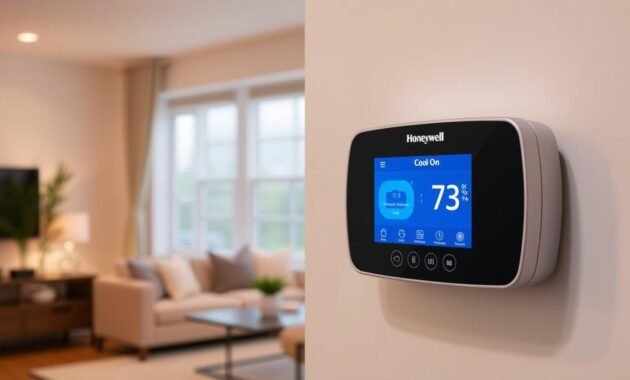
Setting up your Honeywell AC needs careful steps. I’ll show you the key thermostat settings for the best performance. This will help avoid cool on troubleshooting problems.
First, check your system’s basic setup. The right settings boost your HVAC’s efficiency and dependability.
- Select “Cool” mode with “Auto” fan setting
- Confirm correct time and date display
- Check system type and stage configuration
- Verify electrical connections
Understanding your system’s needs is key for thermostat flashing solutions. Each HVAC system has its own setup needs.
| Configuration Step | Recommended Action |
|---|---|
| Terminal Connections | Check R and Rc terminals, use jumper wire if needed |
| System Type | Confirm single or multi-stage cooling system |
| Delay Settings | Set 3-5 minute compressor protection delay |
Always check your manual for model-specific tips. If you’re unsure, call Honeywell support at 1-800-633-3991 during their hours.
Right setup stops system problems and makes your HVAC last longer.
Read also: How Long Does a Septic System Last Expectancy ?
Important Safety Features and Protection Mechanisms
Modern Honeywell thermostats have advanced safety features. These protect your cooling system from damage. They help keep your HVAC system running well for a long time.
Understanding Delay Timers
Delay timers are key to protecting your HVAC system. Honeywell thermostats use these timers to stop the system from cycling too fast. They make sure there’s a 5-10 minute wait between cooling cycles.
This wait time does several things:
- It keeps the compressor from getting too much strain.
- It stops electrical overload.
- It reduces wear on system parts.
- It makes your system more energy-efficient.
Short Cycling Prevention
The thermostat’s cooling delay stops short cycling. Short cycling is when the system turns on and off too often. This can really hurt your HVAC equipment. Honeywell error codes help find problems with these safety features.
Preventing short cycling has many benefits:
- It makes your compressor last longer.
- It uses less energy.
- It keeps your indoor temperature steady.
- It saves on maintenance costs.
Knowing about these safety features helps your cooling system work better. It keeps it safe from mechanical stress.
Conclusion
Understanding the Honeywell thermostat flashing “Cool On” message is key to keeping your home cool. This guide has shown that many problems can be fixed with the right steps. Some issues need simple DIY fixes, while others require a pro.
Regular maintenance is vital to avoid cooling system flashes and HVAC problems. I suggest annual checks, watching your system’s performance, and acting fast on thermostat signals. Being proactive helps protect your HVAC and keeps your home comfortable.
Not all “Cool On” flashes mean trouble. The usual five-minute wait is normal. But, if it keeps blinking after ten minutes, it’s time to dig deeper. Trust your gut, but also get help from certified HVAC pros for complex issues.
With the right steps, your Honeywell thermostat will control temperatures well and give you peace of mind. Stay updated, be alert, and get expert help when needed. This keeps your cooling system working great.
